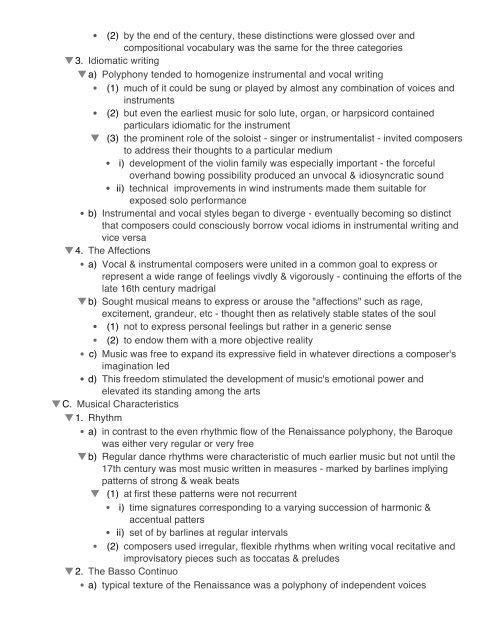An Outline of The History of Western Music Grout ... - The Reel Score
An Outline of The History of Western Music Grout ... - The Reel Score
An Outline of The History of Western Music Grout ... - The Reel Score
You also want an ePaper? Increase the reach of your titles
YUMPU automatically turns print PDFs into web optimized ePapers that Google loves.
(2) by the end <strong>of</strong> the century, these distinctions were glossed over and<br />
compositional vocabulary was the same for the three categories<br />
3. Idiomatic writing<br />
a) Polyphony tended to homogenize instrumental and vocal writing<br />
(1) much <strong>of</strong> it could be sung or played by almost any combination <strong>of</strong> voices and<br />
instruments<br />
(2) but even the earliest music for solo lute, organ, or harpsicord contained<br />
particulars idiomatic for the instrument<br />
(3) the prominent role <strong>of</strong> the soloist - singer or instrumentalist - invited composers<br />
to address their thoughts to a particular medium<br />
i) development <strong>of</strong> the violin family was especially important - the forceful<br />
overhand bowing possibility produced an unvocal & idiosyncratic sound<br />
ii) technical improvements in wind instruments made them suitable for<br />
exposed solo performance<br />
b) Instrumental and vocal styles began to diverge - eventually becoming so distinct<br />
that composers could consciously borrow vocal idioms in instrumental writing and<br />
vice versa<br />
4. <strong>The</strong> Affections<br />
a) Vocal & instrumental composers were united in a common goal to express or<br />
represent a wide range <strong>of</strong> feelings vivdly & vigorously - continuing the efforts <strong>of</strong> the<br />
late 16th century madrigal<br />
b) Sought musical means to express or arouse the "affections" such as rage,<br />
excitement, grandeur, etc - thought then as relatively stable states <strong>of</strong> the soul<br />
(1) not to express personal feelings but rather in a generic sense<br />
(2) to endow them with a more objective reality<br />
c) <strong>Music</strong> was free to expand its expressive field in whatever directions a composer's<br />
imagination led<br />
d) This freedom stimulated the development <strong>of</strong> music's emotional power and<br />
elevated its standing among the arts<br />
C. <strong>Music</strong>al Characteristics<br />
1. Rhythm<br />
a) in contrast to the even rhythmic flow <strong>of</strong> the Renaissance polyphony, the Baroque<br />
was either very regular or very free<br />
b) Regular dance rhythms were characteristic <strong>of</strong> much earlier music but not until the<br />
17th century was most music written in measures - marked by barlines implying<br />
patterns <strong>of</strong> strong & weak beats<br />
(1) at first these patterns were not recurrent<br />
i) time signatures corresponding to a varying succession <strong>of</strong> harmonic &<br />
accentual patters<br />
ii) set <strong>of</strong> by barlines at regular intervals<br />
(2) composers used irregular, flexible rhythms when writing vocal recitative and<br />
improvisatory pieces such as toccatas & preludes<br />
2. <strong>The</strong> Basso Continuo<br />
a) typical texture <strong>of</strong> the Renaissance was a polyphony <strong>of</strong> independent voices<br />
b) typical texture <strong>of</strong> the Baroque period was a firm bass & a florid treble - held<br />
together by unobtrusive harmony





